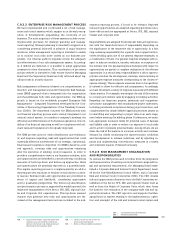Siemens 2012 Annual Report Download - page 208
Download and view the complete annual report
Please find page 208 of the 2012 Siemens annual report below. You can navigate through the pages in the report by either clicking on the pages listed below, or by using the keyword search tool below to find specific information within the annual report.
1 A. To our Shareholders
21 B. Corporate Governance 49 C. Combined Management Report
50 C. Business and economic environment
64 C. Financial performance measures
69 C. Results of operations
82 C. Financial position
93 C. Net assets position
95 C. Overall assessment of the economic position
96 C. Subsequent events
97 C. Sustainability
111 C. Report on expected developments and
associated material opportunities and risks
assists the Managing Board in reporting to the Audit Commit-
tee of the Supervisory Board. The CRIC is composed of the Chief
Risk & Internal Control Officer, as the chairperson, and mem-
bers of senior management such as the Sector and SFS CEOs,
the CFO of Siemens, and selected Heads of Corporate Units.
.. Risks
Below we describe the risks that could have a material adverse
effect on our business, our financial condition and results of
operations, the price of our shares and American depository
shares (ADS), and our reputation. The order in which the risks
are presented in each of the four categories reflects the cur-
rently estimated relative exposure for Siemens associated with
these risks and thus provides an indication of the risks’ current
importance to us. Nevertheless, risks currently considered to
entail a lower risk exposure could potentially result in a higher
negative impact on Siemens than risks currently considered to
entail a higher risk exposure. Additional risks not known to us
or that we currently consider immaterial may also negatively
impact our business operations. We do not expect to incur any
risks that alone or in combination would appear to jeopardize
the continuity of our business.
...
We operate in highly competitive markets, which are
subject to price pressures and rapid changes: The world-
wide markets for our products and solutions are highly com-
petitive in terms of pricing, product and service quality, devel-
opment and introduction ti
me, customer service and financing
terms. In many of our businesses, we face downward price
pressure and we are or could be exposed to market downturns
or slower growth, which may increase in times of declining in-
vestment activities and consumer demand. We face strong
competitors, some of which are larger and may have greater re-
sources in a given business area, as well as competitors from
emerging markets, which may have a better cost structure.
Some industries in which we operate are undergoing consoli-
dation, which may result in stronger competition and a change
in our relative market position. Certain competitors might be
more effective and faster in capturing available market oppor-
tunities, which in turn may negatively impact our market share.
These factors alone or in combination may negatively impact
our business, financial condition, and results of operations.
Our business, financial condition and results of opera-
tions may be affected by the uncertainties of economic
and political conditions, particularly in the current mac-
roeconomic environment, which is characterized by the
continuing crisis in financial markets and the potential
threat of a global economic downturn: Our business envi-
ronment is influenced by conditions in the domestic and glob-
al economies. Since the second half of fiscal , we have
seen a high degree of volatility in the global financial markets,
primarily as a result of the ongoing Eurozone sovereign debt
crisis. The uncertainty in the macroeconomic environment be-
came more and more present in our business segments result-
ing in a more challenging overall business climate in fiscal
. Future economic developments and, in consequence,
the speed of macroeconomic growth and the sustainability of
our market environment are dependent upon the evolution of
()
1 The term Sector in this chart comprises Sectors, SFS and SRE.
Implement ERM system and ensure management and monitoring of risks and opportunities in their respective organization.
Oversees the effectiveness of the risk management and
internal control system.
Audit Committee
Oversee the risk and internal control activities for their area of responsibility and provide
the Management with information necessary to report to the CRIC.
Sector Risk & Internal
Control Committees
Cluster Risk & Internal
Control Committees
Heads of Corporate UnitsSector Management Cluster Management
Overall responsibility for the Risk and Internal Control System.
Defines risk policy and ERM strategy.
Managing Board
Chairman of the CRIC. Defines and monitors application of ERM strategy,
policy and methodology. Consolidates Siemens wide risk and opportunity
profile for CRIC.
Reports to and supports the Managing Board in matters relating
to the implementation, operation and oversight of an effective
Risk and Internal Control System.
Corporate Risk & Internal Control Committee (CRIC) Chief Risk & Internal Control Officer
























